Polymorphic Phase Transition and Piezoelectric Performance of BaTiO3-CaSnO3 Solid Solutions
Abstract
1. Introduction
2. Materials and Methods
3. Results and Discussion
3.1. Phase Structure
3.2. Dielectric Properties
3.3. Phase Transition
3.4. Microstructural Properties
3.5. Piezoelectric Properties
3.6. Ferroelectric Properties
4. Conclusions
Author Contributions
Funding
Data Availability Statement
Conflicts of Interest
References
- Shrout, T.R.; Zhang, S.J. Lead-free piezoelectric ceramics: Alternatives for PZT? J. Electroceram. 2007, 19, 113–126. [Google Scholar] [CrossRef]
- Rödel, J.; Jo, W.; Seifert, K.T.P.; Anton, E.-M.; Granzow, T.; Damjanovic, D. Perspective on the Development of Lead-free Piezoceramics. J. Am. Ceram. Soc. 2009, 92, 1153–1177. [Google Scholar] [CrossRef]
- Li, W.; Xu, Z.; Chu, R.; Fu, P.; Zang, G. Enhanced ferroelectric properties in (Ba1−xCax)(Ti0.94Sn0.06)O3 lead-free ceramics. J. Eur. Ceram. Soc. 2012, 32, 517–520. [Google Scholar] [CrossRef]
- Wu, B.; Xiao, D.; Wu, W.; Zhu, J.; Chen, Q.; Wu, J. Microstructure and electrical properties of (Ba0.98Ca0.02)(Ti0.94Sn0.06)O3-modified Bi0.51Na0.50TiO3 lead-free ceramics. Ceram. Int. 2012, 38, 5677–5681. [Google Scholar] [CrossRef]
- Panda, P.K. Review: Environmental friendly lead-free piezoelectric materials. J. Mater. Sci. 2009, 44, 5049–5062. [Google Scholar] [CrossRef]
- Takenaka, T.; Maruyama, K.-I.; Sakata, K. (Bi1/2Na1/2)TiO3-BaTiO3 System for Lead-Free Piezoelectric Ceramics. Jpn. J. Appl. Phys. 1991, 30, 2236–2239. [Google Scholar] [CrossRef]
- Liu, W.; Ren, X. Large Piezoelectric Effect in Pb-Free Ceramics. Phys. Rev. Lett. 2009, 103, 257602. [Google Scholar] [CrossRef]
- Horchidan, N.; Padurariu, L.; Ciomaga, C.E.; Curecheriu, L.; Airimioaei, M.; Doroftei, F.; Tufescu, F.; Mitoseriu, L. Room temperature phase superposition as origin of enhanced functional properties in BaTiO3-based ceramics. J. Eur. Ceram. Soc. 2020, 40, 1258–1268. [Google Scholar] [CrossRef]
- Tan, Y.; Viola, G.; Koval, V.; Yu, C.; Mahajan, A.; Zhang, J.; Zhang, H.; Zhou, X.; Tarakina, N.V.; Yan, H. On the origin of grain size effects in Ba(Ti0.96Sn0.04)O3 perovskite ceramics. J. Eur. Ceram. Soc. 2019, 39, 2064–2075. [Google Scholar] [CrossRef]
- Pomyai, P.; Munthala, D.; Sonklin, T.; Supruangnet, R.; Nakajima, H.; Janphuang, P.; Dale, S.M.; Glaum, J.; Pojprapai, S. Electrical fatigue behavior of Ba0.85Ca0.15Zr0.1Ti0.9O3 ceramics under different oxygen concentrations. J. Eur. Ceram. Soc. 2021, 41, 2497–2505. [Google Scholar] [CrossRef]
- Ahart, M.; Somayazulu, M.; Cohen, R.E.; Ganesh, P.; Dera, P.; Mao, H.-K.; Hemley, R.J.; Ren, Y.; Liermann, P.; Wu, Z. Origin of morphotropic phase boundaries in ferroelectrics. Nature 2008, 451, 545–548. [Google Scholar] [CrossRef]
- Kutnjak, Z.; Petzelt, J.; Blinc, R. The giant electromechanical response in ferroelectric relaxors as a critical phenomenon. Nature 2006, 441, 956–959. [Google Scholar] [CrossRef] [PubMed]
- Gao, J.; Xue, D.; Wang, Y.; Wang, D.; Zhang, L.; Wu, H.; Guo, S.; Bao, H.; Zhou, C.; Liu, W.; et al. Microstructure basis for strong piezoelectricity in Pb-free Ba(Zr0.2Ti0.8)O3-(Ba0.7Ca0.3)TiO3 ceramics. Appl. Phys. Lett. 2011, 99, 092901. [Google Scholar] [CrossRef]
- Gao, J.; Zhang, L.; Xue, D.; Kimoto, T.; Song, M.; Zhong, L.; Ren, X. Symmetry determination on Pb-free piezoceramic 0.5Ba(Zr0.2Ti0.8)O3-0.5(Ba0.7Ca0.3)TiO3 using convergent beam electron diffraction method. J. Appl. Phys. 2014, 115, 054108. [Google Scholar] [CrossRef]
- Xue, D.; Zhou, Y.; Bao, H.; Zhou, C.; Gao, J.; Ren, X. Elastic, piezoelectric, and dielectric properties of Ba(Zr0.2Ti0.8)O3-50(Ba0.7Ca0.3)TiO3 Pb-free ceramic at the morphotropic phase boundary. J. Appl. Phys. 2011, 109, 054110. [Google Scholar] [CrossRef]
- Damjanovic, D. A morphotropic phase boundary system based on polarization rotation and polarization extension. Appl. Phys. Lett. 2010, 97, 062906. [Google Scholar] [CrossRef]
- Zhou, C.; Liu, W.; Xue, D.; Ren, X.; Bao, H.; Gao, J.; Zhang, L. Triple-point-type morphotropic phase boundary based large piezoelectric Pb-free material-Ba(Ti0.8Hf0.2)O3-(Ba0.7Ca0.3)TiO3. Appl. Phys. Lett. 2012, 100, 222910. [Google Scholar] [CrossRef]
- Fu, H.; Cohen, R.E. Polarization rotation mechanism for ultrahigh electromechanical response in single-crystal piezoelectrics. Nature 2000, 403, 281–283. [Google Scholar] [CrossRef]
- Zhang, L.; Zhang, M.; Wang, L.; Zhou, C.; Zhang, Z.; Yao, Y.; Zhang, L.; Xue, D.; Lou, X.; Ren, X. Phase transitions and the piezoelectricity around morphotropic phase boundary in Ba(Zr0.2Ti0.8)O3-x(Ba0.7Ca0.3)TiO3 lead-free solid solution. Appl. Phys. Lett. 2014, 105, 162908. [Google Scholar] [CrossRef]
- Zhao, L.; Ke, X.; Zhou, Z.; Liao, X.; Li, J.; Wang, Y.; Wu, M.; Li, T.; Bai, Y.; Ren, X. Large electrocaloric effect over a wide temperature range in BaTiO3-modified lead-free ceramics. J. Mater. Chem. C 2019, 7, 1353–1358. [Google Scholar] [CrossRef]
- Gao, J.; Ke, X.; Acosta, M.; Glaum, J.; Ren, X. High piezoelectricity by multiphase coexisting point: Barium titanate derivatives. MRS Bull. 2018, 43, 595–599. [Google Scholar] [CrossRef]
- Guo, H.; Voas, B.K.; Zhang, S.; Zhou, C.; Ren, X.; Beckman, S.P.; Tan, X. Polarization alignment, phase transition, and piezoelectricity development in polycrystalline 0.5Ba(Zr0.2Ti0.8)O3-0.5(Ba0.7Ca0.3)TiO3. Phys. Rev. B 2014, 90, 014103. [Google Scholar] [CrossRef]
- Xue, D.; Zhou, Y.; Bao, H.; Gao, J.; Zhou, C.; Ren, X. Large piezoelectric effect in Pb-free Ba(Ti,Sn)O3-x(Ba,Ca)TiO3 ceramics. Appl. Phys. Lett. 2011, 99, 122901. [Google Scholar] [CrossRef]
- Zhou, P.-F.; Zhang, B.-P.; Zhao, L.; Zhao, X.-K.; Zhu, L.-F.; Cheng, L.-Q.; Li, J.-F. High piezoelectricity due to multiphase coexistence in low-temperature sintered (Ba,Ca)(Ti,Sn)O3-CuOx ceramics. Appl. Phys. Lett. 2013, 103, 172904. [Google Scholar] [CrossRef]
- Zhu, L.-F.; Zhang, B.-P.; Zhao, X.-K.; Zhao, L.; Yao, F.-Z.; Han, X.; Zhou, P.-F.; Li, J.-F. Phase transition and high piezoelectricity in (Ba,Ca)(Ti1-xSnx)O3 lead-free ceramics. Appl. Phys. Lett. 2013, 103, 072905. [Google Scholar] [CrossRef]
- Chen, Z.; Li, Z.; Ma, M.; Zhao, T.; Qiu, J.; Ding, J. Effect of Nd2O3 doping on the electrical properties of Ba0.96Ca0.04Ti0.90Sn0.10O3 ceramics. J. Rare Earths 2018, 36, 745–749. [Google Scholar] [CrossRef]
- Zhao, L.; Zhang, B.-P.; Wang, W.-Y.; Ding, Y.-H.; Zhang, S.-M.; Zhu, L.-F.; Wang, N. Effect of B2O3 on phase structure and electrical properties of CuO-modified (Ba,Ca)(Ti,Sn)O3 lead-free piezoceramics sintered at a low-temperature. Ceram. Int. 2016, 42, 7366–7372. [Google Scholar] [CrossRef]
- Zhao, L.; Zhang, B.-P.; Zhou, P.-F.; Zhu, L.-F.; Wang, N. Piezoelectric and ferroelectric properties of (Ba,Ca)(Ti,Sn)O3 lead-free ceramics sintered with Li2O additives: Analysis of point defects and phase structures. Ceram. Int. 2016, 42, 1086–1093. [Google Scholar] [CrossRef]
- Noritake, K.; Sakamoto, W.; Yuitoo, I.; Takeuchi, T.; Hayashi, K.; Yogo, T. Fabrication of lead-free piezoelectric Li2CO3-added (Ba,Ca)(Ti,Sn)O3 ceramics under controlled low oxygen partial pressure and their properties. Jpn. J. Appl. Phys. 2017, 57, 021501. [Google Scholar] [CrossRef]
- Chen, Z.-H.; Li, Z.-W.; Xu, J.-J.; Guo, H.-F.; Zhang, B.; Ding, J.-N.; Qiu, J.-H. Improvement on electrical properties of Ba0.9Ca0.1Ti0.9Sn0.1O3 ceramics with the addition of CeO2. J. Alloys Compd. 2017, 720, 562–566. [Google Scholar] [CrossRef]
- Tiwari, V.S.; Singh, N.; Pandey, D. Diffuse ferroelectric transition and relaxational dipolar freezing in (Ba,Sr)TiO3. J. Phys. Condens. Matter 1995, 7, 1441–1460. [Google Scholar] [CrossRef]
- Singh, N.; Pandey, D. Diffuse ferroelectric transition and relaxational dipolar freezing in: II. Role of Sr concentration in the dynamics of freezing. J. Phys. Condens. Matter 1996, 8, 4269–4287. [Google Scholar] [CrossRef]
- Singh, N.; Singh, A.P.; Prasad, C.D.; Pandey, D. Diffuse ferroelectric transition and relaxational dipolar freezing in: III. Role of order parameter fluctuations. J. Phys. Condens. Matter 1996, 8, 7813–7827. [Google Scholar] [CrossRef]
- Ogihara, H.; Randall, C.A.; Trolier-McKinstry, S. Weakly Coupled Relaxor Behavior of BaTiO3-BiScO3 Ceramics. J. Am. Ceram. Soc. 2009, 92, 110–118. [Google Scholar] [CrossRef]
- Shen, Z.; Wang, X.; Luo, B.; Li, L. BaTiO3-BiYbO3 perovskite materials for energy storage applications. J. Mater. Chem. A 2015, 3, 18146–18153. [Google Scholar] [CrossRef]
- Wang, Q.; Gong, P.-M.; Wang, C.-M. High recoverable energy storage density and large energy efficiency simultaneously achieved in BaTiO3-Bi(Zn1/2Zr1/2)O3 relaxor ferroelectrics. Ceram. Int. 2020, 46, 22452–22459. [Google Scholar] [CrossRef]
- Zhao, L.; Zhang, B.-P.; Zhou, P.-F.; Zhao, X.-K.; Zhu, L.-F. Phase Structure and Property Evaluation of (Ba,Ca)(Ti,Sn)O3 Sintered with Li2CO3 Addition at Low Temperature. J. Am. Ceram. Soc. 2014, 97, 2164–2169. [Google Scholar] [CrossRef]
- Wu, J.; Habibul, A.; Cheng, X.; Wang, X.; Zhang, B. Orthorhombic-tetragonal phase coexistence and piezoelectric behavior in (1-x)(Ba,Ca)(Ti,Sn)O3-x(Ba,Ca)(Ti,Zr)O3 lead-free ceramics. Mater. Res. Bull. 2013, 48, 4411–4414. [Google Scholar] [CrossRef]
- Janbua, W.; Bongkarn, T.; Kolodiazhnyi, T.; Vittayakorn, N. High piezoelectric response and polymorphic phase region in the lead-free piezoelectric BaTiO3-CaTiO3-BaSnO3 ternary system. RSC Adv. 2017, 7, 30166–30176. [Google Scholar] [CrossRef]
- Zhu, L.-F.; Zhang, B.-P.; Zhao, X.-K.; Zhao, L.; Zhou, P.-F.; Li, J.-F. Enhanced Piezoelectric Properties of (Ba1-xCax)(Ti0.92Sn0.08)O3 Lead-Free Ceramics. J. Am. Ceram. Soc. 2013, 96, 241–245. [Google Scholar] [CrossRef]
- Zhao, C.; Wang, H.; Xiong, J.; Wu, J. Composition-driven phase boundary and electrical properties in (Ba0.94Ca0.06)(Ti1-xMx)O3 (M = Sn, Hf, Zr) lead-free ceramics. Dalton Trans. 2016, 45, 6466–6480. [Google Scholar] [CrossRef] [PubMed]
- Kalyani, A.K.; Krishnan, H.; Sen, A.; Senyshyn, A.; Ranjan, R. Polarization switching and high piezoelectric response in Sn-modified BaTiO3. Phys. Rev. B 2015, 91, 024101. [Google Scholar] [CrossRef]
- Gao, J.; Hu, X.; Zhang, L.; Li, F.; Zhang, L.; Wang, Y.; Hao, Y.; Zhong, L.; Ren, X. Major contributor to the large piezoelectric response in (1-x)Ba(Zr0.2Ti0.8)O3-x(Ba0.7Ca0.3)TiO3 ceramics: Domain wall motion. Appl. Phys. Lett. 2014, 104, 252909. [Google Scholar] [CrossRef]
- Donohue, J.; Miller, S.J.; Cline, R.F. The effect of various substituents on the lattice constants of tetragonal titanate. Acta Cryst. 1958, 11, 693–695. [Google Scholar] [CrossRef]
- Acosta, M.; Novak, N.; Rojas, V.; Patel, S.; Vaish, R.; Koruza, J.; Rossetti, G.A.; Rödel, J. BaTiO3-based piezoelectrics: Fundamentals, current status, and perspectives. Appl. Phys. Rev. 2017, 4, 041305. [Google Scholar] [CrossRef]
- Lei, C.; Bokov, A.A.; Ye, Z.G. Ferroelectric to relaxor crossover and dielectric phase diagram in the BaTiO3-BaSnO3 system. J. Appl. Phys. 2007, 101, 084105. [Google Scholar] [CrossRef]
- Du, F.; Cui, B.; Cheng, H.; Niu, R.; Chang, Z. Synthesis, characterization, and dielectric properties of Ba(Ti1-xSnx)O3 nanopowders and ceramics. Mater. Res. Bull. 2009, 44, 1930–1934. [Google Scholar] [CrossRef]
- Frey, M.H.; Payne, D.A. Grain-size effect on structure and phase transformations for barium titanate. Phys. Rev. B 1996, 54, 3158–3168. [Google Scholar] [CrossRef]
- Chen, Y.; Ye, H.; Wang, X.; Li, Y.; Yao, X. Grain size effects on the electric and mechanical properties of submicro BaTiO3 ceramics. J. Eur. Ceram. Soc. 2020, 40, 391–400. [Google Scholar] [CrossRef]
- Zhu, L.-F.; Zhang, B.-P.; Zhao, L.; Li, S.; Zhou, Y.; Shi, X.-C.; Wang, N. Large piezoelectric effect of (Ba,Ca)TiO3-xBa(Sn,Ti)O3 lead-free ceramics. J. Eur. Ceram. Soc. 2016, 36, 1017–1024. [Google Scholar] [CrossRef]
- Long, P.; Liu, X.; Long, X.; Yi, Z. Dielectric relaxation, impedance spectra, piezoelectric properties of (Ba, Ca)(Ti, Sn)O3 ceramics and their multilayer piezoelectric actuators. J. Alloys Compd. 2017, 706, 234–243. [Google Scholar] [CrossRef]
- Thomas, N.W. A new framework for understanding relaxor ferroelectrics. J. Phys. Chem. Solids 1990, 51, 1419–1431. [Google Scholar] [CrossRef]
- Chen, M.; Xu, Q.; Kim, B.H.; Ahn, B.K.; Chen, W. Effect of CeO2 addition on structure and electrical properties of (Na0.5Bi0.5)0.93Ba0.07TiO3 ceramics prepared by citric method. Mater. Res. Bull. 2008, 43, 1420–1430. [Google Scholar] [CrossRef]
- Zhang, M.-H.; Wang, K.; Zhou, J.-S.; Zhou, J.-J.; Chu, X.; Lv, X.; Wu, J.; Li, J.-F. Thermally stable piezoelectric properties of (K, Na)NbO3-based lead-free perovskite with rhombohedral-tetragonal coexisting phase. Acta Mater. 2017, 122, 344–351. [Google Scholar] [CrossRef]


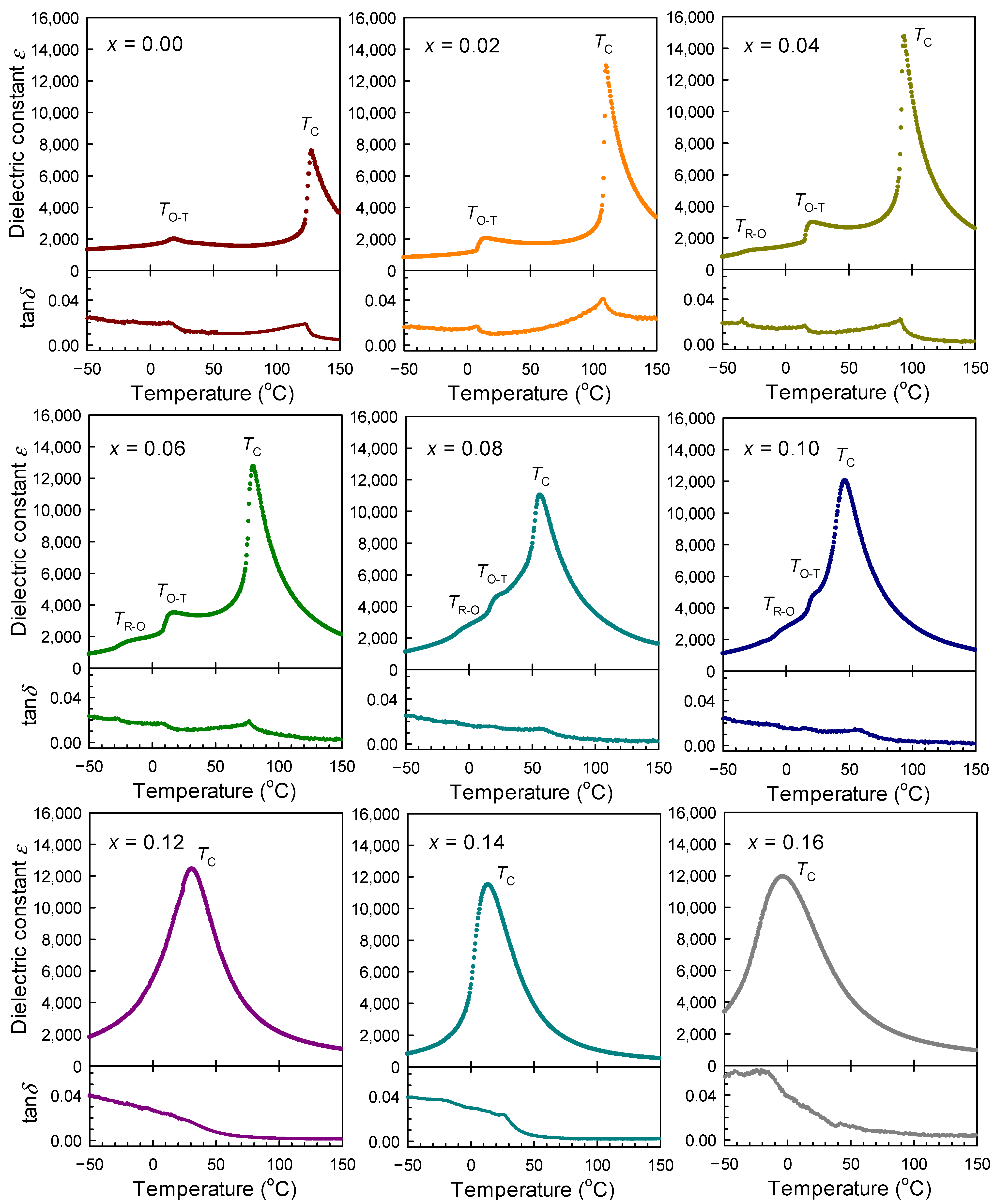
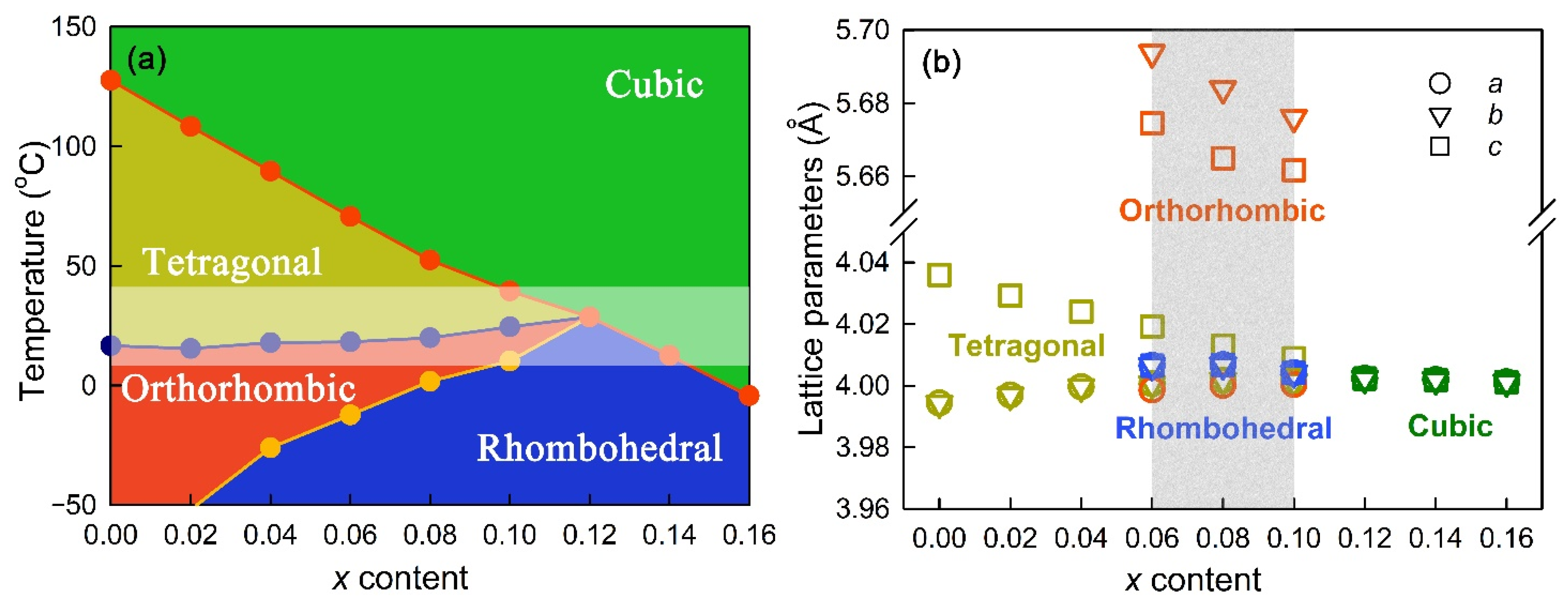
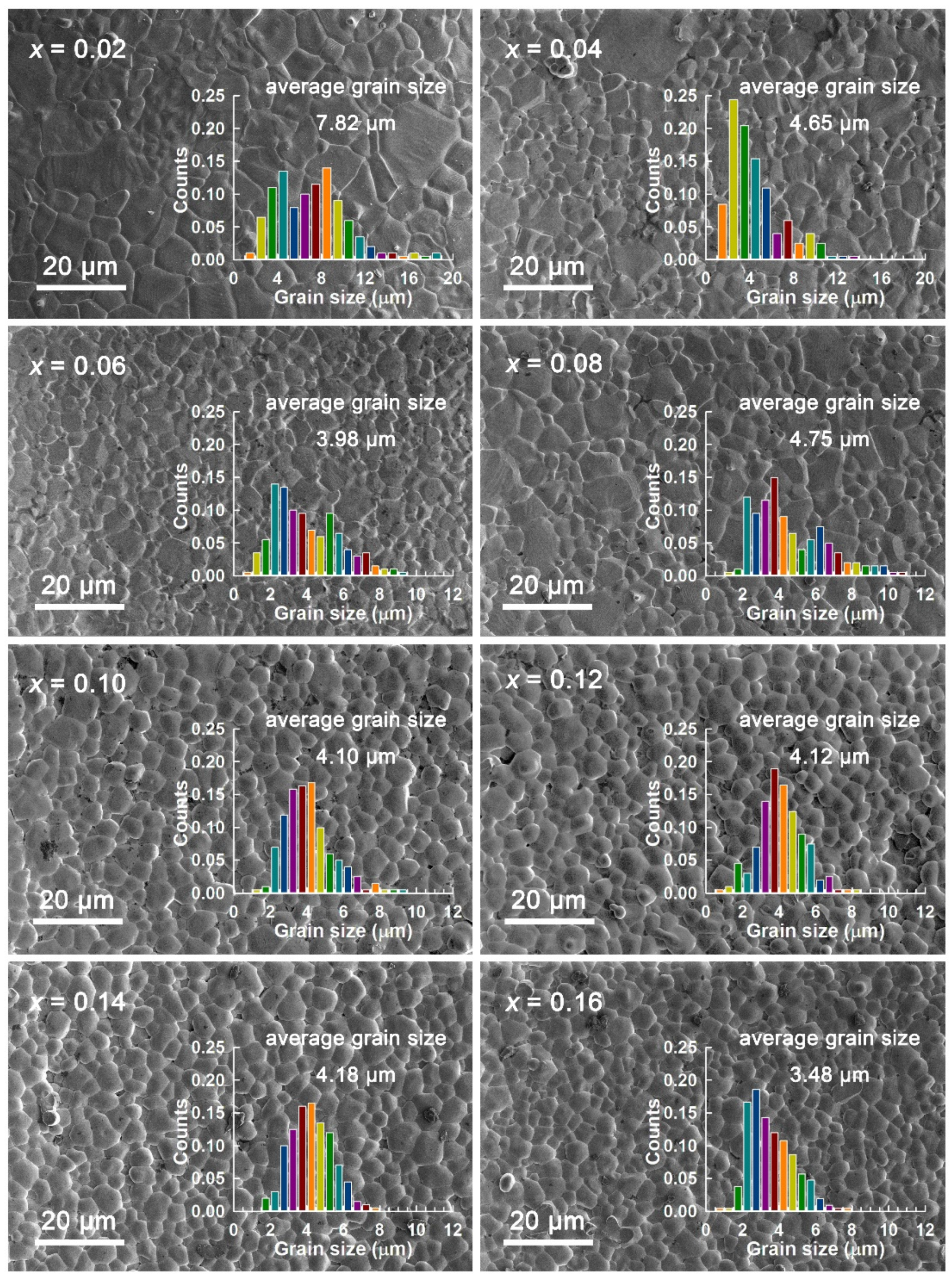
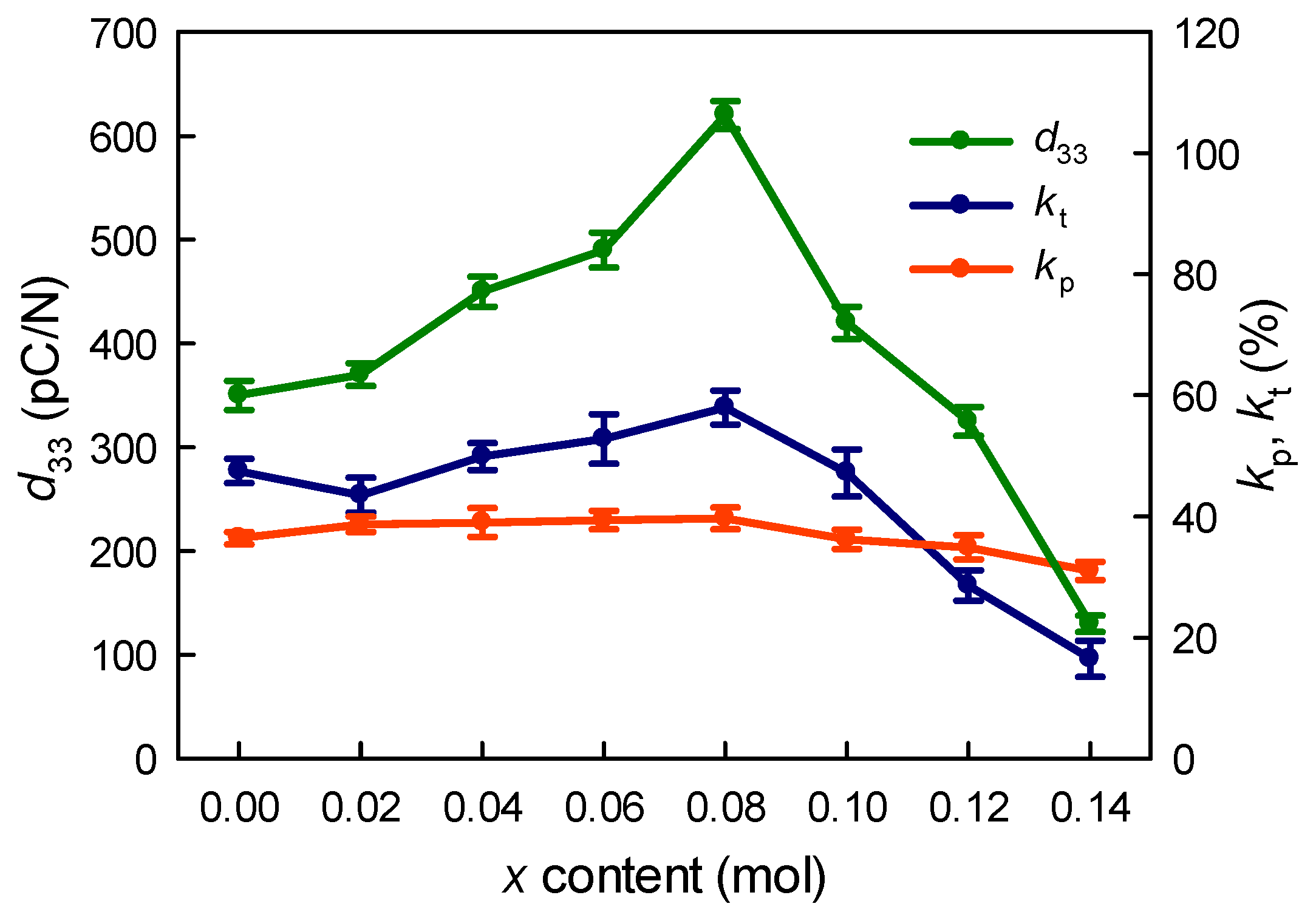
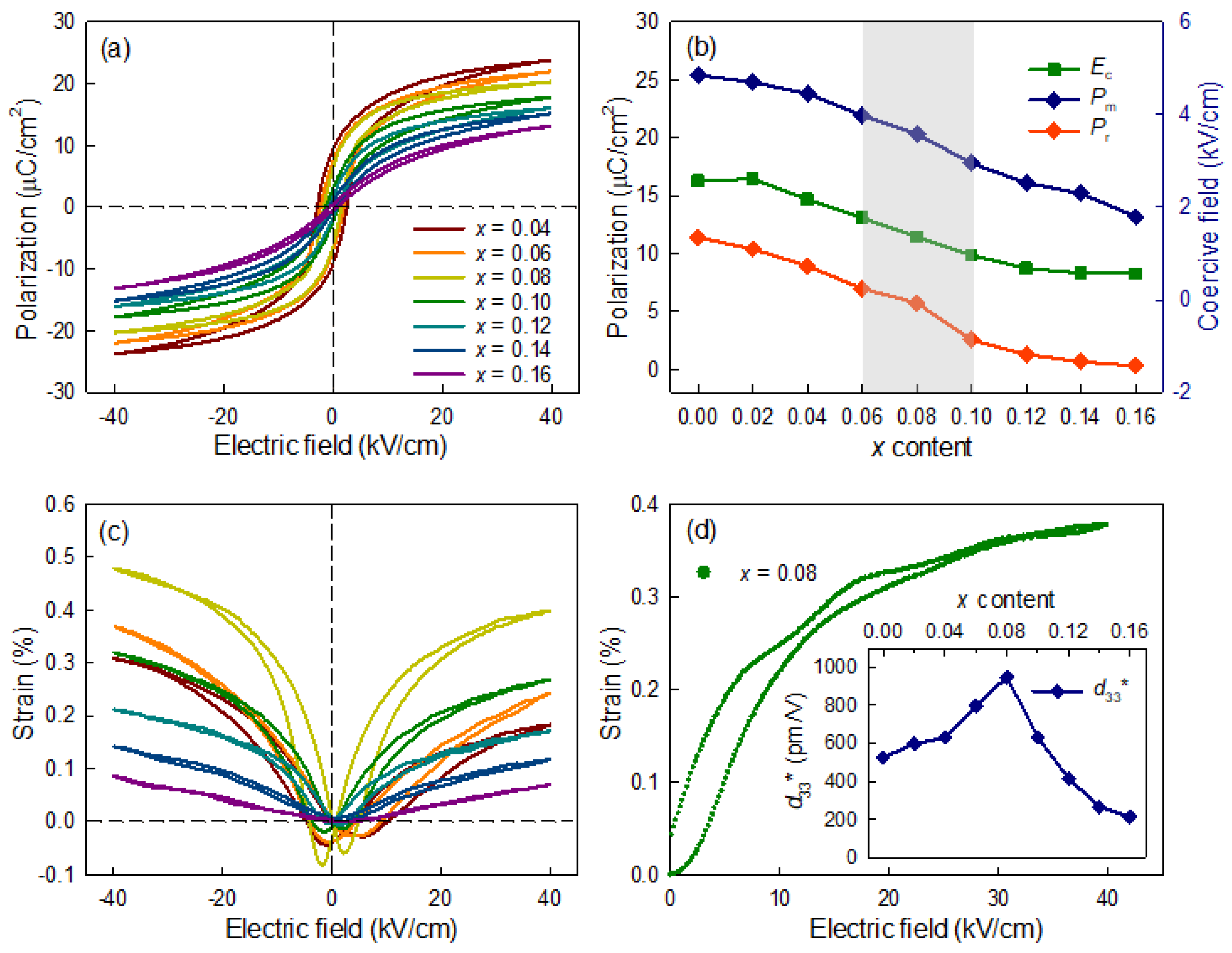
| x | εr * | tanδ (%) * | TR-O (°C) | TO-T (°C) | TC (°C) |
|---|---|---|---|---|---|
| 0.00 | 1966 | 1.23 | - | 16.6 | 126.9 |
| 0.02 | 1979 | 0.97 | - | 15.4 | 110.3 |
| 0.04 | 2955 | 1.15 | −26.1 | 17.9 | 93.6 |
| 0.06 | 3462 | 1.18 | −12.9 | 18.2 | 79.6 |
| 0.08 | 4410 | 1.32 | −1.7 | 19.9 | 52.4 |
| 0.10 | 4809 | 1.37 | 5.2 | 24.5 | 42.5 |
| 0.12 | 10,091 | 2.02 | - | - | 28.6 |
| 0.14 | 10,811 | 2.36 | - | - | 12.5 |
| 0.16 | 8803 | 2.43 | - | - | −4.3 |
| x | Pm (μC/cm2) | Pr (μC/cm2) | EC (kV/cm) | d33(pC/N) | d33*(pm/V) |
|---|---|---|---|---|---|
| 0.00 | 25.4 | 11.40 | 2.57 | 352 | 525 |
| 0.02 | 24.8 | 10.39 | 2.61 | 374 | 598 |
| 0.04 | 23.8 | 8.92 | 2.17 | 450 | 629 |
| 0.06 | 22.0 | 6.99 | 1.77 | 491 | 799 |
| 0.08 | 20.3 | 5.74 | 1.36 | 620 | 950 |
| 0.10 | 17.8 | 2.55 | 0.97 | 420 | 633 |
| 0.12 | 16.1 | 1.29 | 0.68 | 325 | 414 |
| 0.14 | 15.2 | 0.68 | 0.58 | 130 | 265 |
| 0.16 | 13.2 | 0.29 | 0.57 | - | 210 |
Publisher’s Note: MDPI stays neutral with regard to jurisdictional claims in published maps and institutional affiliations. |
© 2021 by the authors. Licensee MDPI, Basel, Switzerland. This article is an open access article distributed under the terms and conditions of the Creative Commons Attribution (CC BY) license (https://creativecommons.org/licenses/by/4.0/).
Share and Cite
Wang, Q.; Yan, H.-Z.; Zhao, X.; Wang, C.-M. Polymorphic Phase Transition and Piezoelectric Performance of BaTiO3-CaSnO3 Solid Solutions. Actuators 2021, 10, 129. https://doi.org/10.3390/act10060129
Wang Q, Yan H-Z, Zhao X, Wang C-M. Polymorphic Phase Transition and Piezoelectric Performance of BaTiO3-CaSnO3 Solid Solutions. Actuators. 2021; 10(6):129. https://doi.org/10.3390/act10060129
Chicago/Turabian StyleWang, Qian, Hong-Ze Yan, Xian Zhao, and Chun-Ming Wang. 2021. "Polymorphic Phase Transition and Piezoelectric Performance of BaTiO3-CaSnO3 Solid Solutions" Actuators 10, no. 6: 129. https://doi.org/10.3390/act10060129
APA StyleWang, Q., Yan, H.-Z., Zhao, X., & Wang, C.-M. (2021). Polymorphic Phase Transition and Piezoelectric Performance of BaTiO3-CaSnO3 Solid Solutions. Actuators, 10(6), 129. https://doi.org/10.3390/act10060129








